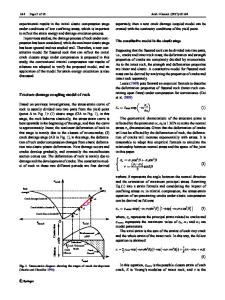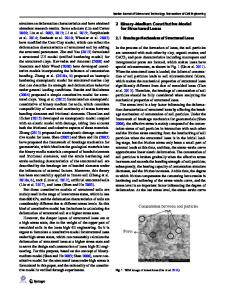Research on Microscopic Fracture Morphology and Damage Constitutive Model of Red Sandstone Under Seepage Pressure
- PDF / 2,891,511 Bytes
- 16 Pages / 595.276 x 790.866 pts Page_size
- 80 Downloads / 283 Views
Original Paper
Research on Microscopic Fracture Morphology and Damage Constitutive Model of Red Sandstone Under Seepage Pressure Weijing Xiao,1,2 Dongming Zhang,1,2,4 Xiaojun Wang,3 Han Yang,1,2 Xiaolei Wang,1,2 and Chenyu Wang1,2 Received 6 November 2019; accepted 24 February 2020
To explore the influence of seepage pressure on rock failure, the high-pressure triaxial automatic system was used to carry out a triaxial compression test under the condition of seepage pressure on rock samples, and then, the fracture surface of the rock was tested by scanning electron microscope (SEM). The fractal dimension features of rock fractures under different seepage pressures were analyzed by the image segmentation principle and optimal threshold method, and a segmental statistical damage constitutive model considering seepage pressure was established based on the Weibull distribution theory. The results show that (1) the SEM image after binarization has better fractal characteristics, which can represent the roughness of the fracture surface; (2) the fractal dimension ranges from 1.818 to 1.950, which shows a variation law of decreasing with the increase in the seepage pressure; and (3) a piecewise damage constitutive model considering the seepage pressure is proposed, and it provides a more precise prediction for the stress–strain curve characteristics before the peak stress. The research results are beneficial and useful for the analysis of the damage evolution characteristics of engineering rock masses, as well as for the monitoring and prediction of engineering geological hazards. KEY WORDS: Rock mechanics, Seepage pressure, Fracture morphology, Fractal dimension, Constitutive model, Weibull distribution.
INTRODUCTION The stability of engineering rock masses is affected by both internal and multiple external factors (Liu et al. 2017; Masoudian et al. 2018; Lv et al. 1
State Key Laboratory of Coal Mine Disaster Dynamics and Control, Chongqing University, Chongqing 400044, China. 2 School of Resources and Safety Engineering, Chongqing University, Chongqing 400044, China. 3 College of Resources and Environmental Engineering, Jiangxi University of Science and Technology, Ganzhou 341000, Jiangxi, China. 4 To whom correspondence should be addressed; e-mail: [email protected]
2019). Among all the influencing factors, water is one of the main causes of geological disasters. With the continuous infiltration of external water into the rock mass, the ability of the rock to resist external damage gradually decreases. Especially for open-pit slope engineering, the continuous infiltration of rainwater will change the rock strength of the slope platform (open-pit step). External disturbance stress, such as blasting vibration, could increase the likelihood of geological disasters such as landslides. Therefore, the study of the rock fracture mechanism under water seepage has significance for slope engineering disaster prevention and control (Chen 2017). For macro-fractures generated inside a rock
Ó 2020 International Association for
Data Loading...











